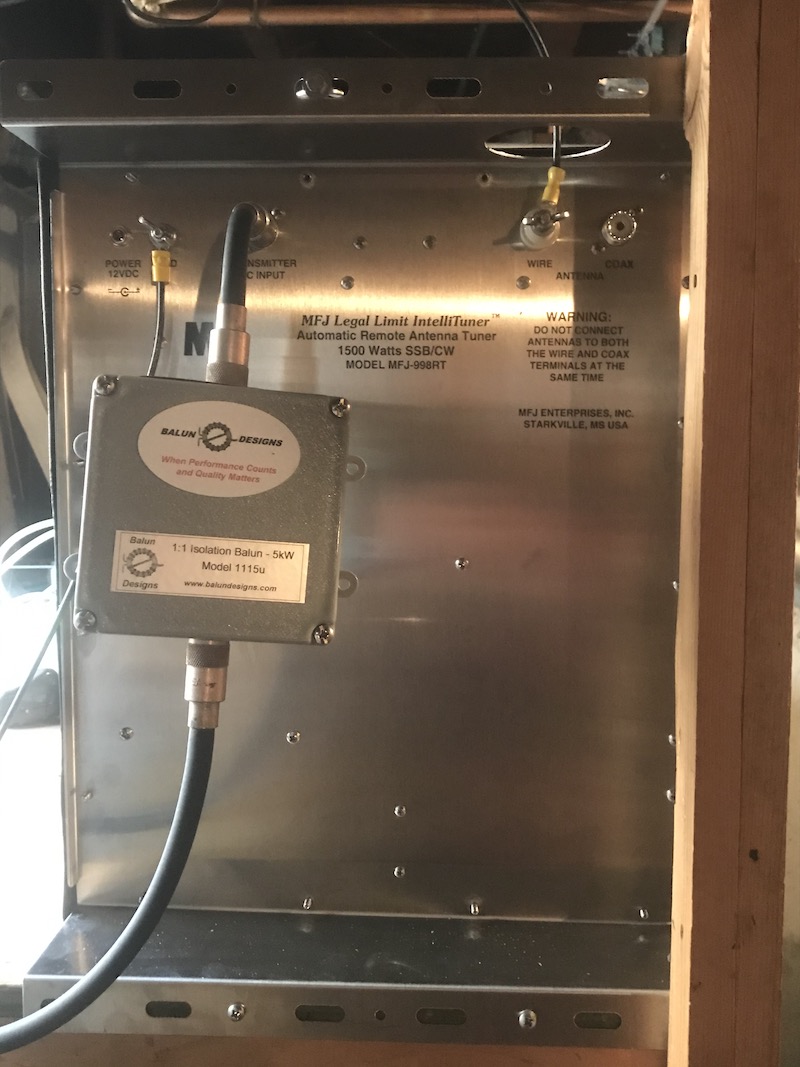Northfield-MFJ-998RT
Contents
Installation
The bottom of the unit which faces toward the operating position. The ground connection is on the upper left and the antenna wire feeds through a hole on the top edge of mounting frame to its high voltage connection point on the upper right. The square box in the feed line is a Balun Designs 1:1 Isolation Balun (Model 1115u) to keep RF off the coax. The tuner is powered directly through the DC power jack mounted on the tuner itself. If mounted outdoors the unit would use the feed line and the “Bias T” unit. The tuner is held in place by a single screw into the self’s wooden vertical member seen on the black “MFJ” logo side and the bottom edge of the tuner is resting on the shelf itself so that screw is not supporting any of the tuner’s fairly substantial weight. Two small screws are also installed along the bottom edge to hold it securely in place.
Operating Instructions
First, and foremost, the Flex’s internal antenna tuner must be turned off, ”ATU” button in a dark color, and the display in “Bypass” mode with Ant. 1 from now on. We don’t want the Flex‘s internal and the MFJ external antenna tuners fighting with each other to find a match.
Second, the MFJ tuner is pretty sensitive about how much power is used for it to perform the tuning process. Always make sure the ”Tune Pwr” slider that sets the Flex’s tune up power level is set to 10 watts. To start the tuning process with the MFJ tuner, just activate the “TUNE” button on the Flex control panel. Be patient, the tuning process can take as long as 30 seconds or more.
The MFJ tuner is currently set to its factory default settings and it appears that it will search for a match and stop as soon as it finds a match with an SWR reading of approximately 2:1 or less. On the Flex’s SWR display any final reading that is to the left of the 2.5:1 threshold is OK for now. The “SWR” letters above that display scale are the 2:1 SWR point. I will eventually tweak some of the MFJ tuner’s internal parameters a bit to try to optimize this later.
60 Meter Considerations
With the new auto antenna tuner installed always use USB on 60 phone, not LSB and the maximum bandwidth allowed per channel is 2.8 KHz. There are five defined channels on 60 for us to use. There are “center frequencies” for CW, RTTY and the digital modes and there are “offset frequencies” for USB. All the activity I have heard there so far has been USB. Here are the offset frequencies for USB you can directly enter on the the Flex for phone QSOs:
5.3305 5.3465 5.3570 5.3715 5.4035
Observations from KK9H
So far I have tried it on 160, 80, 60 and 40. By the way, the inverted-L is a full-wave antenna on 40 and it has truly been “Da Bomb” for me when chasing DX due to its gain. Heaven only knows what the radiation pattern looks like, but it frequently beats my vertical by a noticeable mount. Pretty neat that we can now operate on 60 but be sure to read the exact frequencies we can use there because the the Flex programming is very precise as to where the rig will actually allow you to transmit on that band. Everything is USB on phone, but you have to adjust for the carrier frequency. You can also use CW and digital modes now too.
